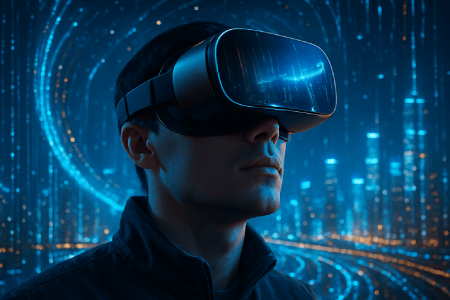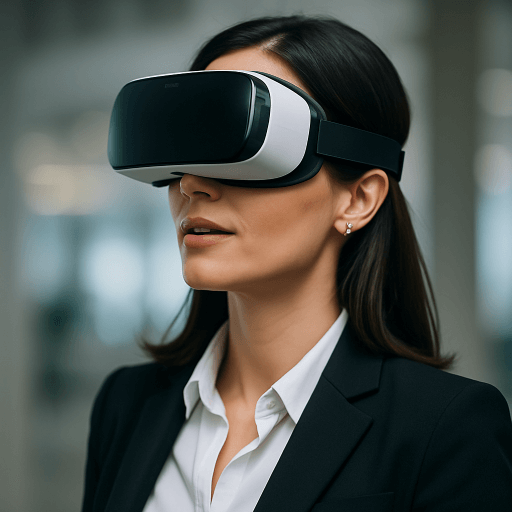The Future is Now: Diving Deep into Virtual Reality’s Next Frontier
Virtual Reality (VR) has long been a staple of science fiction, promising immersive worlds and unparalleled experiences. From the clunky headsets of early prototypes to the sleek, powerful devices of today, VR has undergone a remarkable transformation. What was once a niche technology primarily associated with gaming is rapidly evolving into a versatile tool with far-reaching implications across numerous industries. This article will delve into the exciting future of VR, exploring the advancements that are shaping its trajectory, the expanding applications beyond entertainment, and the profound impact it will have on our daily lives. We will examine how VR is poised to redefine everything from education and healthcare to social interaction and professional collaboration, ultimately demonstrating that the future of virtual reality is not just a distant dream, but a rapidly unfolding reality.
Hardware Advancements and the Dawn of Hyper-Realism

The journey of virtual reality from a nascent concept to a tangible, transformative technology has been significantly propelled by relentless innovation in hardware. Early VR systems were often cumbersome, expensive, and limited in their ability to deliver truly immersive experiences. Fast forward to today, and we are witnessing a rapid evolution in VR headsets, processing power, and display technologies that are paving the way for hyper-realistic virtual worlds.
The Evolution of VR Headsets: Lighter, Faster, More Accessible
One of the most noticeable trends in VR hardware is the continuous effort to make headsets more comfortable, powerful, and affordable. Devices like the Meta Quest 3, priced at a more accessible point, have democratized VR, bringing high-quality immersive experiences to a broader audience [1]. This trend of increasing accessibility is crucial for widespread adoption. Beyond affordability, manufacturers are focusing on reducing the physical burden of VR. Lighter designs, improved ergonomics, and better weight distribution are addressing the issue of ‘VR fatigue,’ allowing for longer and more comfortable sessions. Companies like BigScreen Beyond and MeganeX are at the forefront of this, producing headsets that are a fraction of the size of their predecessors, directly tackling comfort and wearability [2].
Simultaneously, the processing power within standalone VR headsets is experiencing a significant boost. Innovations from chipmakers like Qualcomm are enabling these devices to handle more complex graphics and demanding applications without being tethered to powerful PCs. This self-sufficiency is a game-changer, offering users unprecedented freedom of movement and ease of use. The introduction of high-resolution displays, such as those found in the Apple Vision Pro, has set a new benchmark for visual fidelity, offering unparalleled immersion and nearly unmatched visual clarity [2]. The pursuit of ‘retina-level displays’ is pushing the boundaries of what’s visually possible in VR, making virtual environments indistinguishable from reality for the human eye.
The Quest for Hyper-Realism: Bridging the Sensory Gap
Hyper-realism in VR is not just about stunning visuals; it’s about engaging all senses to create an experience that blurs the line between the virtual and the real. While visual advancements are paramount, the future of VR is increasingly focused on sensory immersion. Imagine feeling the subtle vibrations of a virtual earthquake, the warmth of a digital campfire, or even the scent of a virtual forest. This multi-sensory engagement is the next frontier in hyper-realistic VR.
Technologies like advanced haptic feedback systems, including specialized gloves and bodysuits, are becoming more sophisticated, allowing users to ‘feel’ virtual objects and environments with remarkable accuracy [2]. The development of VR treadmills and specialized shoes aims to address motion sickness and enhance physical immersion, enabling users to walk, run, and interact naturally within virtual spaces [2]. Furthermore, advancements in spatial audio are creating incredibly realistic soundscapes that contribute significantly to the sense of presence within a virtual world. The integration of AI is also playing a pivotal role, allowing VR experiences to adapt to user behavior and preferences, creating dynamic and responsive virtual environments that feel truly alive [1]. This continuous pursuit of sensory realism is transforming VR from a visual spectacle into a holistic, believable experience.
Expanding Applications Beyond Gaming: VR’s Diverse Impact

While gaming has been the primary driver of VR’s initial popularity, the technology’s true potential lies in its diverse applications across various sectors. Virtual reality is rapidly transcending entertainment, becoming an indispensable tool for training, collaboration, design, and even therapy. Its ability to create immersive, interactive, and risk-free environments makes it ideal for scenarios where real-world practice is impractical, dangerous, or costly.
Revolutionizing Education and Training
One of the most impactful areas where VR is making significant strides is in education and training. Immersive educational experiences are transforming traditional learning paradigms, allowing students to explore historical events, dissect complex biological structures, or even journey through the cosmos as if they were truly there [1]. This hands-on, experiential learning fosters deeper engagement and comprehension, moving beyond rote memorization to true understanding. In vocational training, VR offers unparalleled opportunities for skill development. Surgeons can practice intricate procedures in a virtual operating room, pilots can simulate emergency scenarios, and engineers can assemble complex machinery without the need for expensive physical prototypes. This not only reduces training costs but also minimizes risks associated with real-world mistakes, ensuring a highly skilled and confident workforce.
Transforming the Workplace: Collaboration and Productivity
The future of work is increasingly intertwined with virtual reality. VR is revolutionizing how teams collaborate, especially in an era of remote and hybrid work models. Virtual meeting rooms, populated by realistic avatars, are becoming common, allowing colleagues from across the globe to interact as if they were in the same physical space [2]. These immersive environments facilitate more natural communication, foster a stronger sense of presence, and enhance creative brainstorming sessions. Beyond meetings, VR is being utilized for product design and prototyping, enabling designers and engineers to visualize, manipulate, and refine 3D models in a shared virtual space. This accelerates the design cycle, reduces errors, and leads to more innovative solutions. The integration of VR into enterprise solutions is expected to grow significantly, with companies embracing it for everything from customer service to complex data visualization [1].
Healthcare, Therapy, and Beyond
The healthcare sector is another frontier where VR is demonstrating immense promise. Beyond surgical training, VR is being used for pain management, allowing patients to immerse themselves in calming virtual environments to distract from discomfort. It’s also proving effective in various therapeutic applications, such as treating phobias, PTSD, and anxiety disorders through controlled exposure therapy in a safe virtual setting. The ability to simulate real-world scenarios allows therapists to guide patients through challenging situations, helping them develop coping mechanisms and build resilience. Furthermore, VR is finding applications in rehabilitation, assisting patients in regaining motor skills and cognitive functions through engaging and interactive exercises.
Beyond these major sectors, VR’s influence is expanding into retail, real estate, tourism, and even art. Virtual showrooms allow customers to explore products in 3D, virtual tours enable prospective buyers to experience properties remotely, and immersive historical reconstructions offer unique cultural experiences. The versatility of VR is truly remarkable, and as the technology continues to mature, its applications will only become more widespread and impactful.
The Integration of AI and the Rise of Social VR

The future of virtual reality is not a solitary journey; it is increasingly intertwined with the advancements in Artificial Intelligence (AI) and the burgeoning landscape of social VR platforms. These two forces are converging to create more personalized, intuitive, and connected virtual experiences, fundamentally reshaping how we interact with digital worlds and with each other.
AI as the Brains Behind the Virtual World
Artificial intelligence is rapidly becoming the invisible engine driving the next generation of VR experiences. AI algorithms are being deployed to analyze user behavior and preferences, allowing virtual environments to dynamically adapt and personalize content in real-time [1]. Imagine a VR game where the difficulty adjusts seamlessly to your skill level, or a virtual training simulation that identifies your weaknesses and provides tailored exercises. This level of responsiveness, powered by AI, makes VR experiences more engaging and effective.
Beyond personalization, AI is enhancing the realism and interactivity of virtual worlds. AI-powered non-player characters (NPCs) are becoming more sophisticated, exhibiting believable behaviors and engaging in natural language conversations. This is crucial for creating truly immersive narratives and realistic simulations. Furthermore, AI is instrumental in optimizing VR performance, enabling features like foveated rendering, where only the area of the display that the user is directly looking at is rendered in high resolution, thus saving computational power without sacrificing visual quality. Platforms like Google’s Android XR are designed to accelerate the integration of AI into VR, providing developers with tools and access to powerful AI ecosystems like Gemini, which can facilitate everything from content creation to real-time translation within VR environments [2]. This symbiotic relationship between AI and VR is paving the way for virtual worlds that are not just visually stunning, but also intelligent, adaptive, and truly responsive to the user.
Building Connections: The Evolution of Social VR
The notion of VR as a solitary experience is rapidly becoming a relic of the past. The rise of social VR platforms is transforming virtual reality into a powerful medium for human connection and community building. These platforms allow individuals from disparate geographical locations to interact, communicate, and share experiences in real-time within a shared virtual space [1]. From virtual concerts and art galleries to collaborative workspaces and casual hangouts, social VR is fostering new forms of social interaction and community.
Platforms are becoming increasingly user-friendly, diverse, and focused on creating inclusive environments. Users can customize their avatars, express themselves through virtual gestures, and engage in a wide range of activities, blurring the lines between online and offline social interactions. The ability to host parties, attend events, and participate in multiplayer games within these virtual worlds is creating vibrant digital communities. This trend is particularly significant in an increasingly globalized and remote-work-oriented society, offering a powerful alternative for fostering connection and combating isolation. As the technology matures, social VR is poised to become a fundamental aspect of our digital lives, offering rich, immersive social experiences that go beyond traditional video calls or text-based communication.
The Road Ahead: A Future Shaped by Virtual Reality
The journey of virtual reality has been one of continuous innovation, pushing the boundaries of what is possible in digital immersion. From its early days as a futuristic concept to its current status as a rapidly evolving technology, VR has consistently surprised and delighted with its potential. We have explored the remarkable advancements in hardware, making VR experiences more accessible, comfortable, and visually stunning than ever before. The pursuit of hyper-realism, encompassing not just sight but also touch, sound, and even smell, promises a future where virtual worlds are indistinguishable from our own.
Beyond the technological marvels, the true impact of VR lies in its expanding applications. No longer confined to the realm of gaming, virtual reality is revolutionizing education, offering immersive learning experiences that foster deeper understanding and engagement. In the workplace, it is transforming collaboration, enabling remote teams to connect and innovate in shared virtual spaces. Its therapeutic potential in healthcare, from pain management to phobia treatment, highlights its capacity to improve lives. The seamless integration of Artificial Intelligence is making VR experiences more intelligent, adaptive, and personalized, while the rise of social VR platforms is fostering new forms of human connection and community.
As we look to the future, the trajectory of virtual reality is clear: it will continue to permeate every facet of our lives, reshaping how we learn, work, play, and connect. The challenges of motion sickness, high costs, and content availability are steadily being overcome, paving the way for mass adoption. The convergence of VR with other emerging technologies like augmented reality (AR) and the metaverse promises an even more interconnected and immersive digital landscape.
At VRlex, we are at the forefront of this exciting revolution. We specialize in developing cutting-edge VR solutions tailored to your unique needs, whether you’re looking to create immersive training simulations, innovative collaborative platforms, or engaging entertainment experiences. Our team of expert developers and designers is dedicated to pushing the boundaries of what’s possible in virtual reality, transforming your vision into a breathtaking digital reality.
Ready to step into the future? Contact us today to discuss how our VR development services can help you unlock new possibilities and revolutionize your industry.
